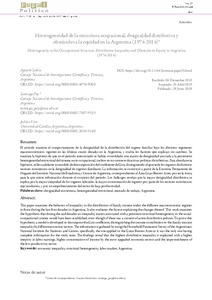Please use this identifier to cite or link to this item:
https://repositorio.uca.edu.ar/handle/123456789/14370| Título: | Heterogeneidad de la estructura ocupacional, desigualdad distributiva y obstáculos ala equidad en la Argentina (1974-2014) Heterogeneity in the occupational structure, distributive inequality and obstacles to equity in Argentina (1974-2014) |
Autor: | Salvia, Agustín Poy Piñeiro, Santiago Vera, Julieta |
Palabras clave: | DESIGUALDAD ECONOMICA; MERCADO DE TRABAJO; POLITICA ECONOMICA; DESIGUALDAD SOCIAL; SALARIOS; TRABAJADORES | Fecha de publicación: | 2020 | Editorial: | Pontificia Universidad Javeriana: Facultad de Ciencias Políticas y Relaciones Internacionales | Cita: | Salvia, A., Poy Piñeiro, S., Vera, J. Heterogeneidad de la estructura ocupacional, desigualdad distributiva y obstáculos ala equidad en la Argentina (1974-2014) [en línea]. Papel político. 2020, 25. doi:10.11144/Javeriana.papo25.heod. Disponible en: https://repositorio.uca.edu.ar/handle/123456789/14370 | Resumen: | Resumen:
El artículo examina el comportamiento de la desigualdad de la distribución del ingreso familiar bajo los distintos regímenes
macroeconómicos vigentes en las últimas cuatro décadas en la Argentina, y evalúa los factores que explican sus cambios. Se
examina la hipótesis de que en el período mencionado se habría consolidado una matriz de desigualdad asociada a la persistente
heterogeneidad estructural del sistema socio-ocupacional, incluso en un contexto de activas políticas distributivas. Para abordar esta
hipótesis, se lleva adelante un modelo de descomposición del coeciente de Gini, distinguiendo el aporte de los ingresos de distintos
sectores económicos en la desigualdad de ingresos familiares. La información se construyó a partir de la Encuesta Permanente de
Hogares del Instituto Nacional de Estadística y Censos de Argentina, correspondientes al Área Gran Buenos Aires, por ser la única
para la que existe información durante el conjunto del período. Los hallazgos revelan que la mayor desigualdad distributiva se
explica por la mayor inequidad de los ingresos laborales, la mayor concentración de ingresos por parte de los sectores económicos
más modernos, y por un empobrecimiento del sector de baja productividad Abstract: This paper examines the behavior of inequality in the distribution of family income under the different macroeconomic regimes in force during the last four decades in Argentina. It also evaluates the factors explaining the changes thereof. This work examines the hypothesis that during the said decades an inequality matrix associated with a persistent structural heterogeneity in the social-occupational systems would have been established, even though if there was a context of active distributive policies. To prove this hypothesis, a model is developed to decompose the Gini coefficient, distinguishing the income contribution to the family-income inequality by different economic sectors. The information is gathered by using the Household Permanent Survey of the Argentinian National Institute for Statistics and Census, specifically, the one applied to the Great Buenos Aires as it was the only one having complete information for the study term. The findings reveal that the highest distributive inequality is explained with a higher inequity in labor earnings, higher concentration of income by the most upgraded economic sectors and the impoverishment of the low-productivity sector |
Cobertura Espacial: | Argentina | Cobertura Temporal: | Siglo XXI Siglo XX |
URI: | https://repositorio.uca.edu.ar/handle/123456789/14370 | ISSN: | 0122-4409 2145-0617 (online) |
Disciplina: | SOCIOLOGIA | DOI: | 10.11144/Javeriana.papo25.heod | Derechos: | Acceso abierto | Fuente: | Papel político. 2020, 25 |
| Appears in Collections: | Colaboraciones en ediciones externas |
Files in This Item:
| File | Description | Size | Format | |
|---|---|---|---|---|
| heterogeneidad-estructura-ocupacional.pdf | 2,66 MB | Adobe PDF |  View/Open |
Page view(s)
69
checked on Apr 27, 2024
Download(s)
55
checked on Apr 27, 2024
Google ScholarTM
Check
Altmetric
Altmetric
This item is licensed under a Creative Commons License

